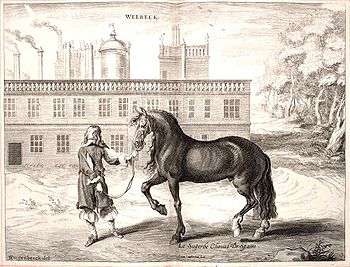Iberian horse
The Iberian horse is a title given to a number of horse breeds native to the Iberian peninsula. At present, no fewer than 18 horse breeds are officially recognized[1][2][3]

Iberian horses are thought to be among the oldest types of domesticated horses. Modern Iberian breeds tend to be of a Baroque horse type that resemble their most famous member, the Andalusian horse, in conformation.
The Lusitano, Sorraia and Garrano are of Portuguese origin, and the remaining are of Spanish. These include the Asturcón, Burguete, Caballo de Monte del País Vasco, Pura Raza Gallega, Pura Raza Española (Andalusian horse), Hispano-Árabe, Hispano-Bretón, Jaca Navarra, Losino, Monchino and Pottoka, as well as the Cavall Mallorquí, Mallorquín and Menorquín (subsets of the Balearic breed[4]).[5] Outside the FAO list, but in the Spanish catalog, a spinoff from the Sorraia, the Marismeño, has also been identified living in the environs of the Doñana National Park [6]
In 2005, a distinctive primitive, feral breed was identified inside the same National Park, the Retuerta horse (Caballo de las retuertas).[7][8]
Roman writers mention in Hispania war horses, wild horses, and ''tieldones'' and small ''asturcones'' in the north.
Procedures have been started to include the Serrano horse.[9] It's a very scarce (less than 40 individuals) mountain big pony variety.
References
- 'FAO breed list', accessed March 15, 2012, cites 3 Portuguese and 20 spanish breeds
- 'R.D. 2129/2008', accessed March 13, 2012, which is the official Spanish list. Only fomento and en peligro de extinción sections, which are the iberian breeds, list 15 breeds. The remaining breeds are of well-known foreign blood, or like the deporte español are recent developments
- Both lists are divergent, partly because the Spanish list is more recent-last changed July 2016- and partly because FAO list as different entities two Mallorquin horses -in Spanish and Catalan- as different breeds. The FAO lists also lacks another breed, Troton Español, which is bred solely in Mallorca
- Genetic characterization of the Spanish Trotter horse breed using microsatellite markers, Genetics and Molecular Biology, accessed November 5, 2009.
- Lopez, María S. et al.. "Mitochondrial DNA Insight On The Evolutionary History Of The Iberian Horses." Poroceedings of the XIV Plant and Animal Genome Conference, 2006. Web page accessed June 17, 2007 at "Mitochondrial DNA Insight On The Evolutionary History Of The Iberian Horses". Archived from the original on 2007-09-27. Retrieved 2007-06-17.
- Royo, L.J.; I. Álvarez; A. Beja-Pereira; A. Molina; I. Fernández; J. Jordana; E. Gómez; J. P. Gutiérrez; F. Goyache (2005). "The Origins of Iberian Horses Assessed via Mitochondrial DNA". Journal of Heredity. 96 (6): 663–669. doi:10.1093/jhered/esi116. PMID 16251517. Retrieved 2008-12-15.
- The Retuertas horse; the "missing link" in the iberoamerican horse breed origin?, Vega-Plà et al 2005, available at eeap.org Archived 2014-04-07 at the Wayback Machine
- (A. Rodero et al, 2008) needs full cite
- 'Proceedings of the Regional Parliament of Madrid' (in Spanish)
External links
- The Origins of Iberian Horses Assessed via Mitochondrial DNA
- International Andalusian & Lusitano Horse Association
- Andalusian Horse Link
- Lusitano Horse Link
- Report on DNA of Spanish horses
- Info on Jaca Navarra (Spanish) (Google translation)
- OSU Losino page
| Wikimedia Commons has media related to Iberian horse. |